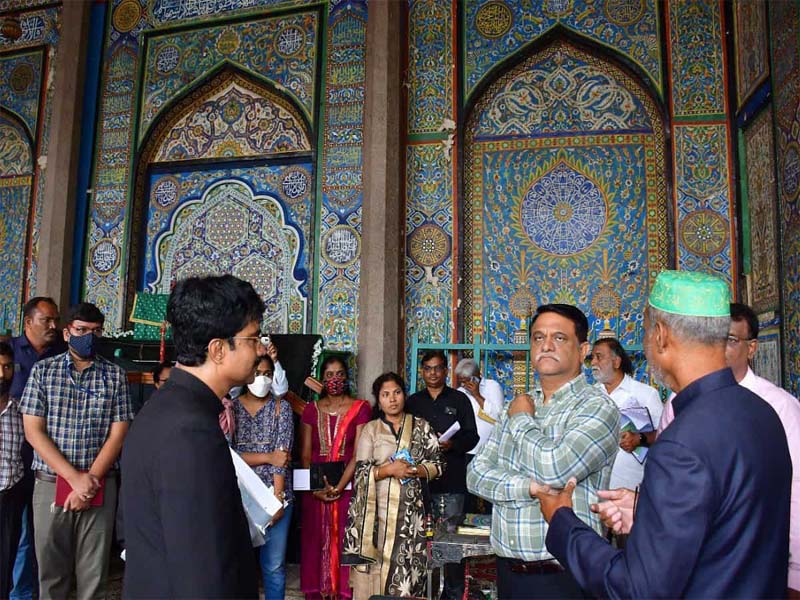To repair three more historic sites, the government signs an MOU with AKTC.
Hyderabad: The Telangana government and the Aga Khan Trust for Culture (AKTC) have signed another memorandum of understanding (MoU) to restore the Saidanima’s tomb Badhshahi Ashurkhana and Shaikpet Sarai in the city after successfully restoring the Qutb Shahi tombs here. Two of the three monuments are not currently open to the general public.
Arvind Kumar, Telangana’s senior secretary for municipal affairs and urban development, tweeted on Friday that the MoU had been signed and that the AKTC would soon begin work on the projects. The historic Qutb Shahi tombs, the royal necropolis of the Qutb Shahi or Golconda dynasty that established Hyderabad, have almost finished their restoration. Since work started there in 2013, the area has almost completely changed.
Ashurkhana Badshahi: Since it was established immediately after the Charminar, which was built in 1591 as the city’s foundation by Mohd Quli Qutb Shah of the Golconda or Qutb Shahi dynasty (1518-1687), the location is a protected heritage site and is the second-oldest landmark in Hyderabad. The site’s construction started in 1592.
The main hall of the Badshahi Ashoorkhana is still standing, despite severe damage to certain nearby open-air constructions like Naqar Khana, Abdar Khana, and Niyaz Khana. All eyes are on the rainbow tiled walls and the overarching theme of flame Alams in this place.
On the southern wall’s arch, a mosaic of staggered hexagons with jewel-like shapes is present. The panel on the western wall is vibrantly coloured in typical Indian hues like mustard yellow and brown, while the side panels of the north-west wall include a huge ‘Alam’ in the centre. Flowers and leaves are arranged in a circling pattern around the compositions.
The floods of 1908 caused damage to the walls of this old building, which were momentarily painted in a similar pattern.Sometime after the Charminar’s construction in 1591, the Badshahi Ashurkhana was built between 1592 and 1596. This Ashoorkhana saw terrible times for nearly a century after the Qutb Shahi dynasty was overthrown by Aurangzeb’s forces in 1687, just like other Ashoorkhanas. And the Badshahi Ashoorkhana was not awarded an annual gift until Nizam Ali (the second ruler of the Asaf Jahi dynasty) assumed power.
The mausoleum of Saidanima was constructed by Diler Jang (1853–1966), also known as Sardar Abdul Haq. He was born in the Bombay Province, which was governed by the British crown, and became well-known in Hyderabad, an earlier state, in the late nineteenth century. Jang was appointed home secretary for the princely state before doing a U-turn in 1885 to become the director of the Nizam’s State Railways.
He visited England in this role as well. Later, Jang constructed a tomb for his mother, Saidanima, which is situated on the north side of the Hussain Sagar reservoir bund road, moving in the direction of Secunderabad. It is a prominent monument that often goes overlooked unless one stops for a moment and takes in his or her surroundings. It is situated considerably far from most historical monuments.
Due to years of negligence and poor upkeep, the baoli (stepwell) inside the historic Saidanima’s tomb on the Hussain Sagar or Tank Bund road has been laying. The rest of the complex, with the exception of the main tomb area, has undoubtedly succumbed to encroachments, as is the situation with many other old Waqf buildings in Hyderabad and Telangana.
Shaikpet Sarai: In Hyderabad, there is a rest stop called The Sarai. The Sarai, which was constructed in the 17th century by the sixth Golconda king Abdullah Qutb Shah (1626-72), comprises 30 rooms as well as stables for horses and camels, a mosque, and a tomb. The Shaikpet Sarai, which is a few kilometres from Golconda Fort, has 500 rooms. It was constructed for international traders who came to Hyderabad.





